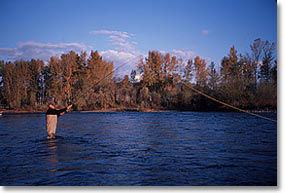
Many of the fly fishing techniques for steelhead have been adapted from those historically developed to catch Atlantic salmon in the British Isles, and later on the eastern seaboard of North America. Flies are swung downstream of the angler on floating or sinking line. The sometimes-violent take usually occurs toward the end of the swing. Modern steelheading also includes nymphing methods similar to those employed by trout anglers.
Winter Steelheaders are often considered the “hard core” of flyfishers, sometimes enduring hours of repeated casting in cold water and freezing conditions for that one tug that can occur when you least expect it. If you’re new to this game, here are a few tips that may help you in your quest for the “silver bullet”.
- Timing Is Everything. Steelhead, unlike trout, are not always in the river system you’re fishing. Additionally, groups of fish move up (or down) the river system as the season progresses. Having up-to-date information from a local source is imperative, and hiring a knowledgeable fly fishing guide will increase your learning curve dramatically.
- Weather Is A Key Factor. Winter storms can turn a fishable river into a brown torrent in a matter of hours.
- Be Patient. Keep your expectations in line. For steelheaders, a great day can sometimes be measured by one good grab. Don’t expect big numbers like you get on Montana tailwater trout fisheries. The most successful steelheaders are those who keep at it, cover the water efficiently, and maintain a positive attitude.
- Understand Steelhead Etiquette. Although most of us would prefer a solitary wilderness experience, many steelhead rivers can have numerous anglers in a particular pool or run where steelhead are concentrated. The new angler entering the water typically takes a position upriver or above the other anglers’ positions (since most steelhead fly presentations are downstream), and in a perfect world, all anglers will gradually move down the pool, fishing it in its entirety. Those reaching the tail of the pool, if they wish to fish the pool again, would reenter above the other anglers. Unfortunately, this is usually the exception than the rule, and many anglers may remain rooted in the same spot for hours. If this were the case, my advice would be to find a position where you are not interfering with other anglers, or better yet, find a new spot.
- Be Properly Equipped. Not all winter steelheading is done in inclement weather, but you better be prepared for it. with appropriate layers of steelhead clothing, such as modern synthetic long underwear, fleece garments, fingerless gloves, wool or synthetic headwear, and wool socks can keep you dry and comfortable all day. Stay away from clothing items that absorb and retain moisture. A well-designed wading rain jacket that fits over all the other stuff is a must. Make sure your wading shoes have enough room for extra socks. Single handed rods should be at least 9 feet, and more often, 9 ½ or ten feet in line weights from 7 to 9. My favorite is the 10 foot 7 weight TLS. The resurgence of double handed rods, from 12 to 15 feet, is evident on today’s western rivers, as they are remarkable tools for covering large water. Floating lines can be used for nymphing and a selection of sinking lines from clear intermediates to extremely fast sink tips are required for winter swinging, depending on water speed and depth.
Best West Coast Steelhead Flies
Steelhead flies are traditionally attractor patterns derived from their Atlantic Salmon counterparts. Although individual choice will vary considerably, as in trout fishing, there are some basic fly patterns that will usually catch fish, regardless of the water. Some anglers also use egg patterns and nymphs with great success.
 Conehead Bunny Muddler |
- Woolly Bugger
- Conehead Bunny Muddler
- Meg-A-Egg Sucking Leech
- Meg-A-Egg
- Kaufmanns Stone
- Stonefly Bugger
- TH Bitch Creek
Dean Schubert has been fly-fishing for steelhead for over 30 years. He was a fishing guide in northern and eastern California for 20 years, director of the Orvis West-Coast Fly Fishing Schools for 12 years, and has been an Orvis sales rep in California for the past seven years. His articles have appeared in most of the major fly fishing magazines.




